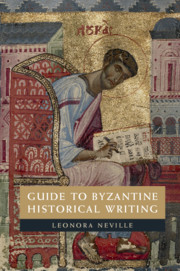Book contents
- Frontmatter
- Dedication
- Contents
- Acknowledgments
- Introduction
- Byzantine Historical Texts
- 1 Theophylakt Simokatta
- 2 Paschal Chronicle
- 3 George Synkellos
- 4 Chronicle of Theophanes
- 5 Patriarch Nikephoros
- 6 Scriptor Incertus de Leo V
- 7 Chronicle of 811
- 8 Megas Chronographos
- 9 George the Monk
- 10 Peter of Alexandria
- 11 Genesios
- 12 Theophanes Continuatus
- 13 Constantinian Excerpts
- 14 John Kaminiates
- 15 Symeon the Logothete
- 16 Leo the Deacon
- 17 Chronicle of Monemvasia
- 18 Chronicon Bruxellense
- 19 Psellos
- 20 John Xiphilinos
- 21 Michael Attaleiates
- 22 John Skylitzes and Scylitzes Continuatus
- 23 George Kedrenos
- 24 Nikephoros Bryennios
- 25 Anna Komnene
- 26 John Kinnamos
- 27 John Zonaras
- 28 Constantine Manasses
- 29 Michael Glykas
- 30 Eustathios of Thessaloniki
- 31 Joel
- 32 Niketas Choniates
- 33 George Akropolites
- 34 Theodore Skoutariotes
- 35 George Pachymeres
- 36 Nikephoros Gregoras
- 37 Ephraim
- 38 Constantine Akropolites the Grand Logothete
- 39 Chronicle of Morea
- 40 Nikephoros Kallistos Xanthopoulos
- 41 John VI Kantakouzenos
- 42 Michael Panaretos
- 43 Chronicle of Ioannina
- 44 Chronicle of Tocco
- 45 John Kananos
- 46 John Anagnostes
- 47 Leontios Machairas
- 48 Sylvester Syropoulos
- 49 Doukas
- 50 George Sphrantzes
- 51 Michael Kritovoulos
- 52 Laonikos Chalkokondyles
- Appendix A Time Periods Covered in the Histories
- Appendix B Timeline of Authors’ Lives
46 - John Anagnostes
from Byzantine Historical Texts
Published online by Cambridge University Press: 14 June 2018
- Frontmatter
- Dedication
- Contents
- Acknowledgments
- Introduction
- Byzantine Historical Texts
- 1 Theophylakt Simokatta
- 2 Paschal Chronicle
- 3 George Synkellos
- 4 Chronicle of Theophanes
- 5 Patriarch Nikephoros
- 6 Scriptor Incertus de Leo V
- 7 Chronicle of 811
- 8 Megas Chronographos
- 9 George the Monk
- 10 Peter of Alexandria
- 11 Genesios
- 12 Theophanes Continuatus
- 13 Constantinian Excerpts
- 14 John Kaminiates
- 15 Symeon the Logothete
- 16 Leo the Deacon
- 17 Chronicle of Monemvasia
- 18 Chronicon Bruxellense
- 19 Psellos
- 20 John Xiphilinos
- 21 Michael Attaleiates
- 22 John Skylitzes and Scylitzes Continuatus
- 23 George Kedrenos
- 24 Nikephoros Bryennios
- 25 Anna Komnene
- 26 John Kinnamos
- 27 John Zonaras
- 28 Constantine Manasses
- 29 Michael Glykas
- 30 Eustathios of Thessaloniki
- 31 Joel
- 32 Niketas Choniates
- 33 George Akropolites
- 34 Theodore Skoutariotes
- 35 George Pachymeres
- 36 Nikephoros Gregoras
- 37 Ephraim
- 38 Constantine Akropolites the Grand Logothete
- 39 Chronicle of Morea
- 40 Nikephoros Kallistos Xanthopoulos
- 41 John VI Kantakouzenos
- 42 Michael Panaretos
- 43 Chronicle of Ioannina
- 44 Chronicle of Tocco
- 45 John Kananos
- 46 John Anagnostes
- 47 Leontios Machairas
- 48 Sylvester Syropoulos
- 49 Doukas
- 50 George Sphrantzes
- 51 Michael Kritovoulos
- 52 Laonikos Chalkokondyles
- Appendix A Time Periods Covered in the Histories
- Appendix B Timeline of Authors’ Lives
Summary
This narrative provides an eyewitness account of the Ottoman capture of Thessaloniki in 1430 and the aftermath of the fall of the city. It is relatively brief, around thirty- eight printed pages. The text is framed as a response to a request for an account of the fall of the city. It is attributed to John Anagnostes, about whom nothing else is known. From his surname, Anagnostes (reader) it can be assumed that he was a member of the clergy.
The account was written sometime after the conflict itself in 1430. Melville- Jones suggests that Anagnostes must have composed the narrative after 1440 due to a reference to a building built by Murad II. The building can be dated to the 1440s based on inscriptions carved on the building.
Giannēs Tsaras argued that Anagnostes's narrative was written by multiple authors because he saw the text as having at least two levels of writing, one more simplistic, and one more emotive and rhetorically elaborate. This assertion has not been generally accepted. Paolo Odorico suggests that an initial account of the sack of the city was later elaborated with detailed descriptions of the aftermath of the city's fall. John Melville- Jones argues that Anagnostes wrote the entirety of his account of the fall of Thessaloniki himself, but chose to use different styles in order to reflect variations in emotion and gravity. At one point in the narrative, Anagnostes refers to others who have written about Thessaloniki, which could refer to his knowledge of John Kaminiates's narrative of the 904 capture of the city by Leo of Tripoli, or to the lamentation by Demetrios Kydones.
Anagnostes begins his narrative with a description of the beauty of the city of Thessaloniki before quickly noting how much the city has suffered under the rule of the Venetians, to whom the city had surrendered in an effort to avoid being conquered by the Ottomans. Archbishop Symeon died in September of 1429, and soon after a series of three messengers came to the city to warn them of imminent attack by the Turkish forces.
- Type
- Chapter
- Information
- Guide to Byzantine Historical Writing , pp. 285 - 288Publisher: Cambridge University PressPrint publication year: 2018

